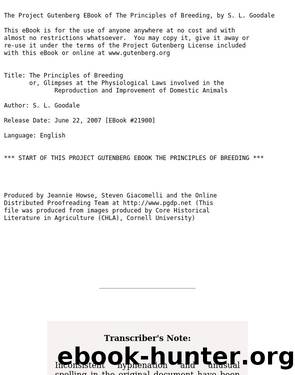The Principles of Breeding or, Glimpses at the Physiological Laws involved in the Reproduction and Improvement of Domestic Animals by S. L. Goodale

Author:S. L. Goodale [Goodale, S. L. (Stephen Lincoln)]
Language: eng
Format: epub
Tags: Livestock, Breeding
Published: 2007-06-21T16:00:00+00:00
* * *
FOOTNOTES:
[19] Philosophical Transactions, 1809.
* * *
CHAPTER VII.ToC
In-and-in Breeding.
It has long been a disputed point whether the system of breeding in-and-in or the opposite one of frequent crossing has the greater tendency to maintain or improve the character of stock. The advocates of both systems are earnest and confident of being in the right. The truth probably is, as in some other similar disputes, that both are right and both wrongâto a certain extent, or within certain limits.
The term in-and-in is often very loosely used and is variously understood; some, and among these several of the best writers, confine the phrase to the coupling of those of exactly the same blood, i.e. brothers and sisters; while others include in it breeding from parents and offspring, and others still employ the term to embrace those of more distant relationship. For the latter, the term breeding in, or close breeding, is deemed more fitting.
The prevalent opinion is decidedly against the practice of breeding from any near relationships; it being usually found that degeneracy follows, and often to a serious degree; but it is not proved that this degeneracy, although very common and even usual, is yet a necessary consequence. That ill effects follow in a majority of cases is not to be doubted, but this is easily and sufficiently accounted for upon other grounds. In a state of nature animals of near affinities interbreed without injurious results, and it is found by experience that where domesticated animals are of a pure race, or of a distinct, well defined and pure breed, the coupling of those of near affinities is not so often followed by injurious effects as when they are crosses, or of mixed or mongrel origin, like the great majority of the cattle in the country at large. In the latter case breeding in-and-in is usually found to result in decided and rapid deterioration. We should consider also that few animals in a state of domestication are wholly free from hereditary defects and diseases, and that these are propagated all the more readily and surely when possessed by both parents, and that those nearly related are more likely than others, to possess similar qualities and tendencies.
If such is to be regarded as the true explanation, it follows that the same method would be also efficacious in perpetuating and confirming good qualities. Such is the fact; and it is well known that nearly all who have achieved eminence as breeders, have availed themselves freely of its benefits. Bakewell, the Messrs. Colling, Mr. Mason, Mr. Bates and others, all practiced it. Mr. Bates' rule was, "breed in-and-in from a bad stock and you cause ruin and devastation, they must always be changing to keep even moderately in caste; but if a good stock be selected, you may breed in-and-in as much as you please."[20] Bakewell originated his famous sheep by crossing from the best he could gather from far or near; but when he had obtained such as suited him, he bred exclusively from within his own.
Download
This site does not store any files on its server. We only index and link to content provided by other sites. Please contact the content providers to delete copyright contents if any and email us, we'll remove relevant links or contents immediately.
| Administration & Medicine Economics | Allied Health Professions |
| Basic Sciences | Dentistry |
| History | Medical Informatics |
| Medicine | Nursing |
| Pharmacology | Psychology |
| Research | Veterinary Medicine |
When Breath Becomes Air by Paul Kalanithi(7264)
Why We Sleep: Unlocking the Power of Sleep and Dreams by Matthew Walker(5644)
Paper Towns by Green John(4169)
The Immortal Life of Henrietta Lacks by Rebecca Skloot(3826)
The Sports Rules Book by Human Kinetics(3589)
Dynamic Alignment Through Imagery by Eric Franklin(3489)
ACSM's Complete Guide to Fitness & Health by ACSM(3469)
Kaplan MCAT Organic Chemistry Review: Created for MCAT 2015 (Kaplan Test Prep) by Kaplan(3423)
Introduction to Kinesiology by Shirl J. Hoffman(3301)
Livewired by David Eagleman(3123)
The River of Consciousness by Oliver Sacks(2992)
Alchemy and Alchemists by C. J. S. Thompson(2912)
The Death of the Heart by Elizabeth Bowen(2902)
Descartes' Error by Antonio Damasio(2733)
Bad Pharma by Ben Goldacre(2730)
Kaplan MCAT Behavioral Sciences Review: Created for MCAT 2015 (Kaplan Test Prep) by Kaplan(2492)
The Gene: An Intimate History by Siddhartha Mukherjee(2492)
The Fate of Rome: Climate, Disease, and the End of an Empire (The Princeton History of the Ancient World) by Kyle Harper(2436)
The Emperor of All Maladies: A Biography of Cancer by Siddhartha Mukherjee(2431)
